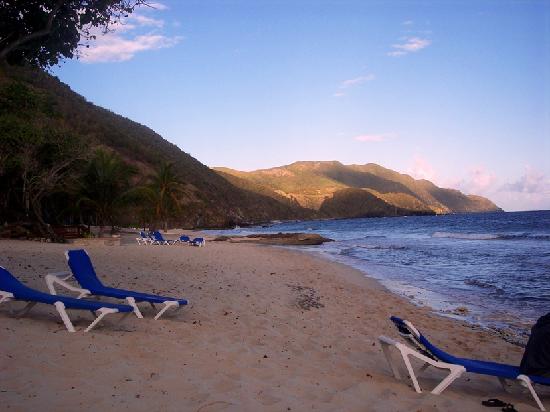 For anyone wanting to get close to nature at its most impressive, the Kruger National Park in South continent is a great place to visit, and is home to every of the so-called big-five animals. Lion Sands is one of a number of private lodges in the park, and is undoubtedly the best. Visitors get to savor two safaris a day, and the resort is so exclusive that less than 20 people can meet there at any one time
For anyone wanting to get close to nature at its most impressive, the Kruger National Park in South continent is a great place to visit, and is home to every of the so-called big-five animals. Lion Sands is one of a number of private lodges in the park, and is undoubtedly the best. Visitors get to savor two safaris a day, and the resort is so exclusive that less than 20 people can meet there at any one time
Thursday, December 31, 2009
Lion Sands Resort, Kruger National Park, South Africa
 For anyone wanting to get close to nature at its most impressive, the Kruger National Park in South continent is a great place to visit, and is home to every of the so-called big-five animals. Lion Sands is one of a number of private lodges in the park, and is undoubtedly the best. Visitors get to savor two safaris a day, and the resort is so exclusive that less than 20 people can meet there at any one time
For anyone wanting to get close to nature at its most impressive, the Kruger National Park in South continent is a great place to visit, and is home to every of the so-called big-five animals. Lion Sands is one of a number of private lodges in the park, and is undoubtedly the best. Visitors get to savor two safaris a day, and the resort is so exclusive that less than 20 people can meet there at any one time
Monday, December 28, 2009
Refeshing to Pitti Palace, Florence, Italy
 the pitti palace
the pitti palaceSaturday, December 26, 2009
Refeshing to The Bellagio, Las Vegas, USA
Thursday, December 24, 2009
Refeshing To Kanuhura, Maldives
 Kanuhura resort
Kanuhura resort Kanuhura is cool
Kanuhura is cool
Tuesday, December 22, 2009
Sunday, December 20, 2009
Tour In Beach Breaks Is Very Cool
 beautiful scenery
beautiful sceneryTop Surfing Destinations in Ireland :
The water temperature in Ireland makes it even more of a effort for the surfer. During the summer months of July and August our ocean temperatures do not commonly rise above 60 (F) degrees on average and in winter the water is obviously even cooler! The period from Sept to May is widely regarded as the prizewinning time to surf in Ireland, and you crapper enjoy the uncrowded breaking waves against a stunning backdrop of royal scenery!
1. Bundoran is widely regarded as Ireland's surfing mecca - it lies in the clifflike coastline of the northerly west of Ireland. The town has an extensive beachfront, and affords the surfer plenty of surf schools, and annual festivals, and locations so aptly titled that you could be surfing at Bondi Beach, Port Elizabeth (J Beach) or in California!! Turfnsurf Lodge is digit such titled place!
In the past Bundoran has hosted the European Surfing Championships as well as the Quicksilver World Masters of 2001.
Bundoran and Donegal Bay have plenty of magnificent surf breaks for the more tasteful surfer, along with many beach breaks that would suit the beginner. The Atlantic around Tullan Strand is specially good. Other beaches in the Atlantic worth sussing out include Mullaghmore, Streedagh and Rossnowlagh.
2. Easkey, County Sligo is located in the North West of Ireland and is an ideal spot for surfing! The digit waves, which are called Easkey Left and Easkey Right are unreal breaking waves, breaking up into perfect paddling channels.
It's digit of the execute surfing spots in Ireland. Surrounded by stunning cliff faces and isolated beaches that are fully exposed to the might of the North Atlantic, it gives a very challenging still continuous wave for the surfer! In 2003, Easkey hosted the World Surf Kayaking Championships and there's a dedicated Surf Club located here.
3. Achill, County Mayo: Keel Strand on Achill Island(3km long) is digit of the most popular surfing points in Ireland. The Atlantic offers medium size waves all year round. The prizewinning winds to look out for are the ones of a northeasterly nature, and the prizewinning behave being westerly - you'll find in the Achill Atlantic that there is a beach facing nearly every direction on the island. Fisheries Cove is also well worth checking out.
4. Lahinch, County Clare: The North Clare town of Lahinch not only is a mecca for golfers and holidaymakers, but it's also perfect for surfing! The beach fortuity is just marvellous for a beginner, and the Atlantic around Crab Island is for the more experienced surfer. The Atlantic offers many various breaks and you have great access to the nearby reefs. You are nearly ever secure waves at Lahinch, with any type of swell.
The Lahinch Surf Shop crapper give you plenty of information on surfing in the area, whether you are a pro or a beginner! The Surf Shop website affords you the analyse of its own surf web cam and surfing report! When you're finished surfing, why not head to the nearby pubs and sample a glorious pint of the black stuff, or if you have time have a ammo of golf at the renowned golf course? The glorious Cliffs of Moher at the nearby village of Liscannor are also well worth a visit!
5. County Waterford: Tramore is widely regarded as digit of the prizewinning surfing locations in Ireland, with great opportunities for the beginner. The Atlantic around Tramore beach is a beach fortuity wave that creates such slower forming waves, which are perfect for the budding surfer! It also offers a wonderful 3-mile south facing line of beach for the more fashioned surfer, with the added challenge of continuously changing beach fortuity waves. Bunmahon, which is located on the Dungarvan and Copper Coast Drive, offers some challenging waves too.
Article Source: http://EzineArticles.com/?expert=Mairead_Fole
Saturday, December 19, 2009
Steam train back on track on Kyushu's Hisatsu Line

Impian Monalisa-Kyushu Railway Co. (JR Kyushu) put a restored steam locomotive, the Hitoyoshi-go, back on the tracks to celebrate the 100th anniversary of the JR Hisatsu Line.
The line was opened on Nov. 21, 1909, to connect Kumamoto and Kagoshima prefectures in Japan's southern island of Kyushu. For security reasons, the Japanese government decided to build the railway in and around the mountains, rather than along the coastline, to avoid gunfire from foreign battleships.
The project faced with a series of difficult challenges, however, including the construction of 60 tunnels and 90 bridges, as well as the nation's first railway spiral and switchback to climb up and down the steep slopes. It was also suspended several times due to the First Sino-Japanese War and the Russo-Japanese War before the railway was finally completed.
In April this year, JR Kyushu resumed the operation of the Hitoyoshi-go between JR Hisatsu Line's Kumamoto and Hitoyoshi stations. The black steamer 8620, which pulls three passenger cars, allows tourists and railway fans to enjoy the beautiful scenery along the Kuma River in Hitoyoshi, Kumamoto Prefecture, as it runs through an old brick tunnels and across an iron bridge dating back to the Meiji Era.
Steam train back on track on Kyushu's Hisatsu Line

Impian Monalisa-Kyushu Railway Co. (JR Kyushu) put a restored steam locomotive, the Hitoyoshi-go, back on the tracks to celebrate the 100th anniversary of the JR Hisatsu Line.
The line was opened on Nov. 21, 1909, to connect Kumamoto and Kagoshima prefectures in Japan's southern island of Kyushu. For security reasons, the Japanese government decided to build the railway in and around the mountains, rather than along the coastline, to avoid gunfire from foreign battleships.
The project faced with a series of difficult challenges, however, including the construction of 60 tunnels and 90 bridges, as well as the nation's first railway spiral and switchback to climb up and down the steep slopes. It was also suspended several times due to the First Sino-Japanese War and the Russo-Japanese War before the railway was finally completed.
In April this year, JR Kyushu resumed the operation of the Hitoyoshi-go between JR Hisatsu Line's Kumamoto and Hitoyoshi stations. The black steamer 8620, which pulls three passenger cars, allows tourists and railway fans to enjoy the beautiful scenery along the Kuma River in Hitoyoshi, Kumamoto Prefecture, as it runs through an old brick tunnels and across an iron bridge dating back to the Meiji Era.
All Nippon Airways set to pick up half of new flight slots at Narita

Impian Monalisa-All Nippon Airways (ANA) will receive about half of the 20,000 flights being added to Narita International Airport's annual capacity starting in March, say insiders at the Ministry of Land, Infrastructure, Transport and Tourism.
The new flights are part of ANA's plans to strengthen its international network, mainly in Asia, with the allotment of the new flight capacity to be officially announced by the ministry in January.
Japan Airlines (JAL), which is in the midst of restructuring and reducing its routes, did not make a request for a portion of the 10,000 added takeoffs and landings reserved for domestic carriers. This is apparently partly because the airline needs to secure enough aircraft for the increased number of flight slots slated for Haneda Airport, also known as Tokyo International Airport.
At present, JAL has about 47,000 of Narita's annual 200,000 fights, against ANA's 26,000. The 20,000 new flights were added by the Ministry of Land, Infrastructure, Transport and Tourism to coincide with the completion of a runway extension project.
JAL, which must complete its restructuring plan by January and reduce 21 international routes by the end of fiscal 2011, will likely reduce its flights in and out of Narita. ANA has requested that the extra flights left in the arrival and departure structure by JAL's route reductions be divided up fairly, and is looking to increase its share.
Until recently, JAL -- which operates more routes than ANA -- had been picking up international routes from its rival, and the new ANA flight slots at Haneda and Narita will narrow that gap.
All Nippon Airways set to pick up half of new flight slots at Narita

Impian Monalisa-All Nippon Airways (ANA) will receive about half of the 20,000 flights being added to Narita International Airport's annual capacity starting in March, say insiders at the Ministry of Land, Infrastructure, Transport and Tourism.
The new flights are part of ANA's plans to strengthen its international network, mainly in Asia, with the allotment of the new flight capacity to be officially announced by the ministry in January.
Japan Airlines (JAL), which is in the midst of restructuring and reducing its routes, did not make a request for a portion of the 10,000 added takeoffs and landings reserved for domestic carriers. This is apparently partly because the airline needs to secure enough aircraft for the increased number of flight slots slated for Haneda Airport, also known as Tokyo International Airport.
At present, JAL has about 47,000 of Narita's annual 200,000 fights, against ANA's 26,000. The 20,000 new flights were added by the Ministry of Land, Infrastructure, Transport and Tourism to coincide with the completion of a runway extension project.
JAL, which must complete its restructuring plan by January and reduce 21 international routes by the end of fiscal 2011, will likely reduce its flights in and out of Narita. ANA has requested that the extra flights left in the arrival and departure structure by JAL's route reductions be divided up fairly, and is looking to increase its share.
Until recently, JAL -- which operates more routes than ANA -- had been picking up international routes from its rival, and the new ANA flight slots at Haneda and Narita will narrow that gap.
Friday, December 18, 2009
Refeshing to Miami Beach is Cool
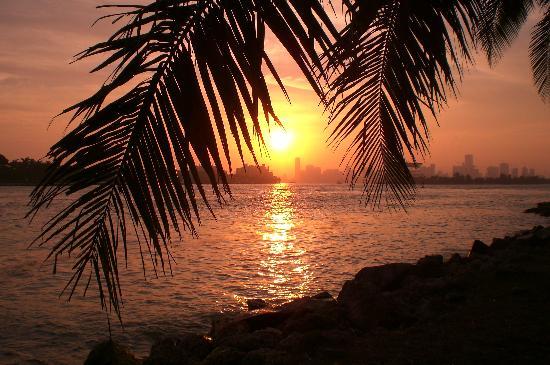 Sunset In Miami Beach
Sunset In Miami BeachTaking a Vacation at Miami Beach :
South Beach is one of the most visited destinations in all of Miami. South Beach is concern renowned for its unique prowess deco landscape. The Fontainebleau and Eden Roc hotels are digit of the most famous prowess deco buildings in the world. Not exclusive does South Beach offer a cultural difference but the dining establishments boast some of the prizewinning food on some menu. Ocean Drive is lined with fabulous places to eat a toothsome meal. Not exclusive can you find a enthusiastic meal, but Ocean Drive has a party spot for everyone. South Beach offers unlimited options for a enthusiastic vacation.
Another enthusiastic place to visit while taking a vacation in Algonquin Beach is the Algonquin Metro Zoo. The Algonquin Metro Zoo is known as one of the prizewinning zoos in the nation. The tropical climate allows the installation to have a difference of animals from places much as Australia, Asia, and Africa. The Algonquin Metro Zoo is home to the endangered Black Rhino and Addux as well as White Tigers, Cuban Crocodiles, and a Komodo Dragon. The Algonquin Metro Zoo's exhibits allow the animals to be cage liberated which give the appearance that the animals are co-mingling, as you would see if you were on a safari.
The Everglades National Park is place that everyone should visit while on vacation in Miami. The Everglades National Park is one of nature's rarest gems, and although a protected area, is being threatened by draining and development. This unique ecosystem is home to 14 rare and endangered species that includes the Florida Panther, West Indian Manatee, and American Crocodile. Not exclusive is the Everglades National Park home to rare species but it is rich in Native American story as well. Evidence of Native American settlers can be traced back as far as the 16th century.
A visit to the Villa Vizcaya continues your tour of Algonquin Beach. Villa Vizcaya is located in Coral Gables, a beautiful and upscale community meet outside of downtown Miami. Villa Vizcaya is a breathtaking site to view. Built by James Deering in 1914, this magnificent realty was crafted from purely authentic materials from Italy and Spain. Pieces of real European castles, dissembled and shipped by boat, were also incorporated into the grand design of this historical estate.
Besides a visit to South Beach the prizewinning way to wrap up your vacation in Algonquin is to take a stroll along one of its many beautiful beaches. Bill Baggs Cape Florida State Park not exclusive has gorgeous views of the ocean but it is home to the famous Cape Florida Lighthouse. Miami's beaches offer a wide difference of activities that include sunbathing, swimming, and snorkeling. No matter where you definite to spend your instance your Algonquin Beach vacation is sure to be an experience that you will treasure for a lifetime.
Article Source: http://EzineArticles.com/?expert=Daniel_Carson
Thursday, December 17, 2009
The long and wine-filled road

Impian Monalisa-In spring, the vines are just starting to grow again, with the harvest due in autumn
Having lived in Melbourne for more than a year, I finally had the chance to go on a winery tour one fine spring weekend.
My good local friend Jen offered to take me to some wineries nearby after she found out I'd seen nothing of Victoria's vineyards except from the tourism brochures.
Our options were either the Grampian or Pyrenees wineries, which along with Ballarat make up the Great Grape Road Touring, wine regions offering visitors a scenic view as well as wide ranges of mouthwatering wine. Ballarat itself is a nice town with rich cultural heritage inherited from the gold rush heyday. The town is an hour's drive from Melbourne.
"It's not as famous as the Yarra Valley, but you'll enjoy the Pyrenees," said Jen, as we decided to head there because from Ballarat, where Jen's mother lives, it is closer than Grampian.
She was right, as the picturesque hilly area was a perfect weekend escape for us.
 The vineyard at the Dalwhinnies’ winery made for a great place for a walk
The vineyard at the Dalwhinnies’ winery made for a great place for a walk
Our journey started at around 10 a.m., after a lazy Saturday breakfast, enjoying various homemade jams made by Barbara, Jen's mother. We were lucky to have good weather, considering it is usually still quite chilly in Ballarat and beyond during October, even with spring upon us.
Along the road was a striking bright yellow canola farm. All kinds of birds, none that I could name, were flying in the clean blue sky.
"It's easy to grow canola here. Mostly it's made into oil and used in the food processing industry," Barbara explained. Every now and then she slowed the car down and pulled over so we could take pictures.
This woman has amazing knowledge about the plants and wildlife of Australia. She tirelessly explained to us different kinds of gum trees, native plants, birds and just about anything that we wanted to know during the road trip.
Barbara also told us that the Pyrenees were named after the rocky mountains that span the border between Spain and France. The vast vineyards first started back in the late 19th century, yet did not last. The modern vineyards were planted in the 1960s.
 So much wine, so little time! Barbara explains about the different grapes and wines.
So much wine, so little time! Barbara explains about the different grapes and wines.
According to the Visit Victoria website, the Pyrenees are home to 44 wineries that grow 25 varieties of grapes. These vineyards helped establish the Pyrenees' reputation as producers for, among others, the savory and spicy reds. The Cabernet Sauvignon, Chardonnay and Sauvignon Blanc are among the best varieties from the region.
At about midday, we arrived at our first winery, the Taltarni Vineyards in Moonambel. It wasn't very busy, so we had a good time tasting different selections of fruity wines. Although I'm far from being an expert wine taster, I would say that I love almost everything offered as long as it's not dry. However, I found the sweet sparkling Late Harvest Riesling 2005 the most flavorsome.
"This is going to be perfect for a lazy Sunday afternoon picnic later *in Melbourne*," my friend Ria said of the sweet and fruity white wine first released in 1999. We ended up buying a bottle each.
Another friend took a nice Cabernet Sauvignon as a gift for her thesis supervisor following a recommendation from the barman.
"It's a good choice. Very moderate as it's not too strong, yet still good for a chill-out time," he said after we told him that we didn't know the supervisor's preference.
 No springtime walk would be complete without a roll in the daisies.
No springtime walk would be complete without a roll in the daisies.
"I suppose he likes red wine, hey?" he added in a broad Australian accent.
We got a little too excited for a bit and began thinking about buying different kinds.
"Take it easy girls, we're heading to more places after this," Barbara warned us.
After quick tea break and a five-minute drive past scenic hilly vineyards, we arrived at our second winery. The Dalwhinnies is a little more isolated and nestled under the brow of a hill. It has a small testing area for visitors with a modern glass design that provides a lovely view of the vineyards down hill. There, guests can also enjoy appetizing snacks and a cheese platter while tasting the wine.
We tried different ranges of white and red, but could not decide what we liked the most. Since the wines were pricey, ranging from A$35 to $150 (US$32 to $136) a bottle, we decided not to buy any - too expensive for a student budget.
The vineyard looked stunning and the spring sunshine was irresistible, so we decided to enjoy a bit of a walk with the dog around the vineyard.
The grape vines had just started growing, yet they still looked beautiful. The best time to enjoy the vineyards is in early autumn in March, when the vines are full of fruit and ready for harvesting.
The hilly landscape reminded us of the highlands around Bandung and Puncak, in West Java, which also make for a perfect weekend getaway. The only difference is that here they are full of grape vines instead of tea plantations.
Spring had sprung, and daisies were blooming everywhere. We made a daisy-chain tiara for Molly the dog, who seemed to enjoy the walk in the stunning hills.
We took a bundle of pictures, and off we went to the next destination. We had a quick check at the Summerfield cellar, tasted some reds and decide that we were too hungry to enjoy the wine.
We then drove to Avoca, a quiet small town with classic old buildings from the gold rush era, to have lunch.
Our initial plan was to go to a caf* offering various old-style Australian meat pies, with different fillings including exotic meats such as kangaroo and crocodile. But a friend just wanted to have a safe lunch, so our choice was a cute little caf*, the Olive and Lavender. The caf* serves homemade food and has a small yard for the dogs.
It was the perfect choice as all the food was tasty. I was satisfied with my feta cheese quiche and a strong latte to keep me awake the rest of the afternoon.
Following lunch, Barbara took us on a small bushwalk around a small waterfall. The walk was good to awaken us before we continued to our final destination, the Mount Avoca winery.
 As dusk begins to fall, kangaroos come out to forage for food, apparently unbothered by traffi c and tourists.
As dusk begins to fall, kangaroos come out to forage for food, apparently unbothered by traffi c and tourists.
Mount Avoca spoiled us with flavorful wines and we ended up buying some. I opted for a white Trios, a blend of the three fruity wines Sauvignon Blanc, Chardonnay and Semillon. I think it's going to be a perfect companion for a seafood dinner or even spicy Indonesian cuisine, as recommended by the woman serving us.
Driving back home, we saw a mob of kangaroos in the bush. About two or three males, which looked bigger than the rest, led the group through the green bush. We pulled the car over and took some pictures of them, which didn't seem to bother them.
Barbara said kangaroos were most likely to be seen during dusk.
"It's time to start hunting for food," she said.
After they disappeared into the bush, we continued our journey back to the city center. The next destination was Maryborough, a small town east of Ballarat, where we would spend the night in Jenny's family property and experience a simple life, but without Paris Hilton and Nicole Richie, in the bush.
"It's gonna be great, girls. My dad has prepared a bonfire and we can roast marshmallows on it. And tomorrow, we should get up early to do some bushwalking in the neighborhood," said Jenny. She added that if we were lucky, kangaroos usually came into the yard around the house in the morning or early evening.
And that really happened. we ended our weekend retreat by filming and chasing tamed kangaroos in bush that evening.
- Photos courtesy of Agustina Wayansari
The long and wine-filled road

Impian Monalisa-In spring, the vines are just starting to grow again, with the harvest due in autumn
Having lived in Melbourne for more than a year, I finally had the chance to go on a winery tour one fine spring weekend.
My good local friend Jen offered to take me to some wineries nearby after she found out I'd seen nothing of Victoria's vineyards except from the tourism brochures.
Our options were either the Grampian or Pyrenees wineries, which along with Ballarat make up the Great Grape Road Touring, wine regions offering visitors a scenic view as well as wide ranges of mouthwatering wine. Ballarat itself is a nice town with rich cultural heritage inherited from the gold rush heyday. The town is an hour's drive from Melbourne.
"It's not as famous as the Yarra Valley, but you'll enjoy the Pyrenees," said Jen, as we decided to head there because from Ballarat, where Jen's mother lives, it is closer than Grampian.
She was right, as the picturesque hilly area was a perfect weekend escape for us.
 The vineyard at the Dalwhinnies’ winery made for a great place for a walk
The vineyard at the Dalwhinnies’ winery made for a great place for a walk
Our journey started at around 10 a.m., after a lazy Saturday breakfast, enjoying various homemade jams made by Barbara, Jen's mother. We were lucky to have good weather, considering it is usually still quite chilly in Ballarat and beyond during October, even with spring upon us.
Along the road was a striking bright yellow canola farm. All kinds of birds, none that I could name, were flying in the clean blue sky.
"It's easy to grow canola here. Mostly it's made into oil and used in the food processing industry," Barbara explained. Every now and then she slowed the car down and pulled over so we could take pictures.
This woman has amazing knowledge about the plants and wildlife of Australia. She tirelessly explained to us different kinds of gum trees, native plants, birds and just about anything that we wanted to know during the road trip.
Barbara also told us that the Pyrenees were named after the rocky mountains that span the border between Spain and France. The vast vineyards first started back in the late 19th century, yet did not last. The modern vineyards were planted in the 1960s.
 So much wine, so little time! Barbara explains about the different grapes and wines.
So much wine, so little time! Barbara explains about the different grapes and wines.
According to the Visit Victoria website, the Pyrenees are home to 44 wineries that grow 25 varieties of grapes. These vineyards helped establish the Pyrenees' reputation as producers for, among others, the savory and spicy reds. The Cabernet Sauvignon, Chardonnay and Sauvignon Blanc are among the best varieties from the region.
At about midday, we arrived at our first winery, the Taltarni Vineyards in Moonambel. It wasn't very busy, so we had a good time tasting different selections of fruity wines. Although I'm far from being an expert wine taster, I would say that I love almost everything offered as long as it's not dry. However, I found the sweet sparkling Late Harvest Riesling 2005 the most flavorsome.
"This is going to be perfect for a lazy Sunday afternoon picnic later *in Melbourne*," my friend Ria said of the sweet and fruity white wine first released in 1999. We ended up buying a bottle each.
Another friend took a nice Cabernet Sauvignon as a gift for her thesis supervisor following a recommendation from the barman.
"It's a good choice. Very moderate as it's not too strong, yet still good for a chill-out time," he said after we told him that we didn't know the supervisor's preference.
 No springtime walk would be complete without a roll in the daisies.
No springtime walk would be complete without a roll in the daisies.
"I suppose he likes red wine, hey?" he added in a broad Australian accent.
We got a little too excited for a bit and began thinking about buying different kinds.
"Take it easy girls, we're heading to more places after this," Barbara warned us.
After quick tea break and a five-minute drive past scenic hilly vineyards, we arrived at our second winery. The Dalwhinnies is a little more isolated and nestled under the brow of a hill. It has a small testing area for visitors with a modern glass design that provides a lovely view of the vineyards down hill. There, guests can also enjoy appetizing snacks and a cheese platter while tasting the wine.
We tried different ranges of white and red, but could not decide what we liked the most. Since the wines were pricey, ranging from A$35 to $150 (US$32 to $136) a bottle, we decided not to buy any - too expensive for a student budget.
The vineyard looked stunning and the spring sunshine was irresistible, so we decided to enjoy a bit of a walk with the dog around the vineyard.
The grape vines had just started growing, yet they still looked beautiful. The best time to enjoy the vineyards is in early autumn in March, when the vines are full of fruit and ready for harvesting.
The hilly landscape reminded us of the highlands around Bandung and Puncak, in West Java, which also make for a perfect weekend getaway. The only difference is that here they are full of grape vines instead of tea plantations.
Spring had sprung, and daisies were blooming everywhere. We made a daisy-chain tiara for Molly the dog, who seemed to enjoy the walk in the stunning hills.
We took a bundle of pictures, and off we went to the next destination. We had a quick check at the Summerfield cellar, tasted some reds and decide that we were too hungry to enjoy the wine.
We then drove to Avoca, a quiet small town with classic old buildings from the gold rush era, to have lunch.
Our initial plan was to go to a caf* offering various old-style Australian meat pies, with different fillings including exotic meats such as kangaroo and crocodile. But a friend just wanted to have a safe lunch, so our choice was a cute little caf*, the Olive and Lavender. The caf* serves homemade food and has a small yard for the dogs.
It was the perfect choice as all the food was tasty. I was satisfied with my feta cheese quiche and a strong latte to keep me awake the rest of the afternoon.
Following lunch, Barbara took us on a small bushwalk around a small waterfall. The walk was good to awaken us before we continued to our final destination, the Mount Avoca winery.
 As dusk begins to fall, kangaroos come out to forage for food, apparently unbothered by traffi c and tourists.
As dusk begins to fall, kangaroos come out to forage for food, apparently unbothered by traffi c and tourists.
Mount Avoca spoiled us with flavorful wines and we ended up buying some. I opted for a white Trios, a blend of the three fruity wines Sauvignon Blanc, Chardonnay and Semillon. I think it's going to be a perfect companion for a seafood dinner or even spicy Indonesian cuisine, as recommended by the woman serving us.
Driving back home, we saw a mob of kangaroos in the bush. About two or three males, which looked bigger than the rest, led the group through the green bush. We pulled the car over and took some pictures of them, which didn't seem to bother them.
Barbara said kangaroos were most likely to be seen during dusk.
"It's time to start hunting for food," she said.
After they disappeared into the bush, we continued our journey back to the city center. The next destination was Maryborough, a small town east of Ballarat, where we would spend the night in Jenny's family property and experience a simple life, but without Paris Hilton and Nicole Richie, in the bush.
"It's gonna be great, girls. My dad has prepared a bonfire and we can roast marshmallows on it. And tomorrow, we should get up early to do some bushwalking in the neighborhood," said Jenny. She added that if we were lucky, kangaroos usually came into the yard around the house in the morning or early evening.
And that really happened. we ended our weekend retreat by filming and chasing tamed kangaroos in bush that evening.
- Photos courtesy of Agustina Wayansari
Carambola Beach Resort and Spa
Carambola Beach Resort was created to celebrate the unspoiled beauty of the Caribbean by Laurance Rockefeller in 1986.
The design of the resort was inspired by the cultural heritage and history of St. Croix and the Virgin Islands:
- Carambola Red roofs reflect St. Croix’s Danish heritage
- Carambola British inspired in-room screened porches
- Carambola Spanish Colonial mahogany woodwork
- Carambola Creole symetry and central entrance
- Carambola land inspired louvered windows
In design, architect William Cox has captured the spirit of a Caribbean-fishing village, with cool spaces, promenades and patios that offer a delightful mixture of privacy and sociability.
We offer a full spectrum of activities and services. Whether you want to spend calibre time with your family on the beach, seek a romantic spa getaway, dream of a destination wedding, search for world-class golf courses, or bring a group for a meeting or event.
source : www.carambolabeach.com
Tuesday, December 15, 2009
Dance Baksa Kembang of South Kalimantan Regional
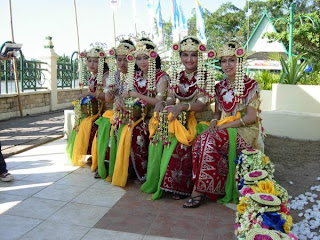 Baksa Kembang dance including classical dance types, which survive and thrive in the palace of Banjar, which is danced by the daughters of the palace. This dance gradually spread to the people of Banjar with dancers galuh-galuh Banjar. This dance is performed to entertain the family palace and greeted guests like a king or a noble prince.
Baksa Kembang dance including classical dance types, which survive and thrive in the palace of Banjar, which is danced by the daughters of the palace. This dance gradually spread to the people of Banjar with dancers galuh-galuh Banjar. This dance is performed to entertain the family palace and greeted guests like a king or a noble prince. After this dance popular in the community in the Land of Banjar, serves to welcome guests state officials in the celebration of the great days of regional or national. Beside that also dances performed in Baksa Kembang Banjar wedding celebration or a celebration such as a host of safety. This dance wearing a pair of hand properties is developing a series of flower Bogam roses, jasmine, and ylang kantil. Bogan flowers will be awarded to guests officials and wife, after it finished taraian danced.
After this dance popular in the community in the Land of Banjar, serves to welcome guests state officials in the celebration of the great days of regional or national. Beside that also dances performed in Baksa Kembang Banjar wedding celebration or a celebration such as a host of safety. This dance wearing a pair of hand properties is developing a series of flower Bogam roses, jasmine, and ylang kantil. Bogan flowers will be awarded to guests officials and wife, after it finished taraian danced. For a brief description, this dance describes teenage daughters beautiful playing in the garden of flowers. They picked some flowers and then assembled into flower blossoms bogam then they bring this bogam enjoying themselves while dancing with a supple. Baksa Kembang dance wear named Elephant Gemuling crowns carved by the flowers that shake, a pair of small bogam flowers placed on the crown and strand woven from coconut leaves called halilipan. Baksa Kembang dance is usually danced by a number of odd count as one person, three people, five men and so on. And is accompanied by a set dance or gamelan tetabuhan to the tune of the song is standard sieves and Janklong or Kambang Muni.
For a brief description, this dance describes teenage daughters beautiful playing in the garden of flowers. They picked some flowers and then assembled into flower blossoms bogam then they bring this bogam enjoying themselves while dancing with a supple. Baksa Kembang dance wear named Elephant Gemuling crowns carved by the flowers that shake, a pair of small bogam flowers placed on the crown and strand woven from coconut leaves called halilipan. Baksa Kembang dance is usually danced by a number of odd count as one person, three people, five men and so on. And is accompanied by a set dance or gamelan tetabuhan to the tune of the song is standard sieves and Janklong or Kambang Muni. Baksa Kembang dance is in the Banjar society there are several versions, this happens every offspring has an individual style but is still a characteristic of the dance Baksa Kembang, like Lagureh, TAPUNG Rope, Kijik, Jumanang. In the 1990s, South Kalimantan Cultural Park gathering berinisiaf dance coaches from all Baksa Kembang to make a version of Dance Baksa Kembang standard. Once there is agreement, then the Dance diadakanlah workshoup participants Baksa Kembanag with representatives from local districts and municipal in South Kalimantan. Although there was a dance dance Baksa Kembang existing version but only revolves around the family or local, but in competitions, festivals or artistic mission out of the South Kalimantan have been dancing for a standardized.
Baksa Kembang dance is in the Banjar society there are several versions, this happens every offspring has an individual style but is still a characteristic of the dance Baksa Kembang, like Lagureh, TAPUNG Rope, Kijik, Jumanang. In the 1990s, South Kalimantan Cultural Park gathering berinisiaf dance coaches from all Baksa Kembang to make a version of Dance Baksa Kembang standard. Once there is agreement, then the Dance diadakanlah workshoup participants Baksa Kembanag with representatives from local districts and municipal in South Kalimantan. Although there was a dance dance Baksa Kembang existing version but only revolves around the family or local, but in competitions, festivals or artistic mission out of the South Kalimantan have been dancing for a standardized.Thursday, December 10, 2009
The Beauty of Batik Pekalongan
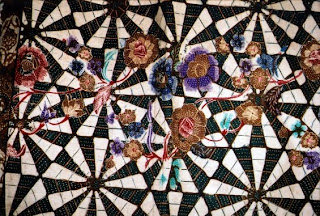 Talking about batik, as if there will be no end, all kinds of Central Javanese batik motifs and how to take care of batik cloth, now we are slightly shifted up towards the north coast of Java, Pekalongan. In this city, the traffic is very high batik trade is extraordinary. They not only accept batik influenced by motives court with kawung colors. Before any further, be helpful to know in advance whether it was true batik technique.
Talking about batik, as if there will be no end, all kinds of Central Javanese batik motifs and how to take care of batik cloth, now we are slightly shifted up towards the north coast of Java, Pekalongan. In this city, the traffic is very high batik trade is extraordinary. They not only accept batik influenced by motives court with kawung colors. Before any further, be helpful to know in advance whether it was true batik technique.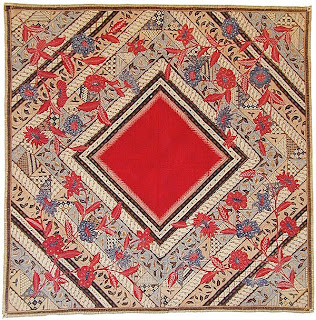 Batik originated from the Javanese word "amba", meaning to write and "nitik". Batik is a technique of creating color by using canting or cap. Then a cloth dipped in color barrier material that is malam (wax), so the dye does not enter. In the English language known as wax-resist dyeing. Coastal Pekalongan batik style and composition has a richer color. Batik patterns are usually adapted to regional circumstances. Like Coastal Batik Pekalongan, symbolizes the motive was nuanced coast. For example marine floral and marine animals. Another case with the dominant Javanese Batik with motives lines, boxes, and other geometrical construction. Although the form of stalks, flowers, and animals still dominate.
Batik originated from the Javanese word "amba", meaning to write and "nitik". Batik is a technique of creating color by using canting or cap. Then a cloth dipped in color barrier material that is malam (wax), so the dye does not enter. In the English language known as wax-resist dyeing. Coastal Pekalongan batik style and composition has a richer color. Batik patterns are usually adapted to regional circumstances. Like Coastal Batik Pekalongan, symbolizes the motive was nuanced coast. For example marine floral and marine animals. Another case with the dominant Javanese Batik with motives lines, boxes, and other geometrical construction. Although the form of stalks, flowers, and animals still dominate. Batik pattern in this region heavily influenced by the culture of Demak thick with the culture of Islam and also the traders who came. No wonder if then they can receive all kinds of colors and images that could finally show their open attitude. Until the early 20th century known batik process is then developed batik with batik stamp at the time of World War raged. Keep in mind also almost all Batik Pekalongan elements include flowers and birds into Hong batik patterns. This pattern is influenced by China. Then why coastal batik motif is more diverse and rich? Many experts argue that batik is because society is much more open beach so brave to express yourself.
Batik pattern in this region heavily influenced by the culture of Demak thick with the culture of Islam and also the traders who came. No wonder if then they can receive all kinds of colors and images that could finally show their open attitude. Until the early 20th century known batik process is then developed batik with batik stamp at the time of World War raged. Keep in mind also almost all Batik Pekalongan elements include flowers and birds into Hong batik patterns. This pattern is influenced by China. Then why coastal batik motif is more diverse and rich? Many experts argue that batik is because society is much more open beach so brave to express yourself.












